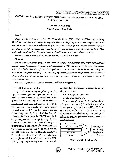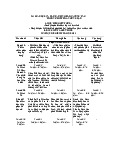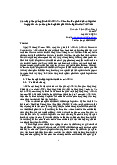



















Preview text:
BỘ GIÁO DỤC VÀ ĐÀO TẠO
TR¯ỜNG ĐẠI HỌC HOA SEN KHOA LOGISTICS & TMQT -- o0o – MÔN HỌC LOGISTICS BÁO CÁO NHÓM GIỮA KỲ ĐỀ TÀI: TRANSPORTATION Gi¿ng viên : Nguyßn Ph°¡ng Liên Nhóm sinh viên thực hián : Nhóm 4 1. Trần Thị Lệ Hằng - 2193349
2. Nguyễn Thanh Trường - 2198697
3. Ph¿m Thái BÁo Ngân - 2193478 4. Dương Hồng Ân - 2193734 5. Trần Thị Lan Mi - 2196968
TP. Hồ Chí Minh, tháng 03 năm 2022
NHẬN XÉT CỦA GI¾NG VIÊN
......................................................................................................................................
......................................................................................................................................
......................................................................................................................................
......................................................................................................................................
......................................................................................................................................
......................................................................................................................................
......................................................................................................................................
......................................................................................................................................
......................................................................................................................................
......................................................................................................................................
......................................................................................................................................
......................................................................................................................................
......................................................................................................................................
......................................................................................................................................
......................................................................................................................................
......................................................................................................................................
......................................................................................................................................
......................................................................................................................................
......................................................................................................................................
TP. Hồ Chí Minh, Ngày … tháng… năm 2021 Người nh¿n xét STT HỌ VÀ TÊN CÔNG VIàC ĐÁNH GIÁ IV 1 Trần Thị Lệ Hằng 100% Nguyễn Thanh 2 100% Trường IV & Word I 3 Ph¿m Thái BÁo Ngân II 100% III 4 Dương Hồng Ân V 100% 5 Trần Thị Lan Mi VI & Powerpoint 100%
NH¾N XÉT CỦA GIÀNG VIÊN ....................................................................................... 2
INTRODUCE ...................................................................................................................... 5
I. Definition ...................................................................................................................... 7 II.
Role of transportation for your selected firm ............................................................ 7
III. Model of Sea transportation that serve my firm ........................................................ 7
The concept of sea transport ........................................................................................... 7
General genes about sea transportation ........................................................................... 8
Special features of sea transportation. ........................................................................ 8
The effect of sea transport on international trade. ...................................................... 8
Technical facilities of sea transport ............................................................................ 8
The development of seaports helps the logistics industry reduce costs, increase
competitiveness and improve service quality. ............................................................. 9
IV. Identify the regulation and law that your firm have to focus on making decision to
install, invest and operate the new transportation means: including bill of lading, necessary
document for global shipping. ........................................................................................... 10
Sales contract : ............................................................................................................... 11
Commercial Invoice : .................................................................................................... 12
Packing List : ................................................................................................................. 13
Bill of lading : ................................................................................................................ 15
Certificate of Origin (C/O) : .......................................................................................... 16
V. Which strategy does your firm develop to handle the transportation for minimizing
transportation cost and why. It may include: Features of the mode of sea transport; Factors
affect sea transportation: material, technique. Method of chartering a ship to transport
goods .................................................................................................................................. 18 INTRODUCE
Transport is the lifeblood of the economy, development of transportation will promote
other economic sectors to develop accordingly. In the current era of globalization,
transportation plays a very important role, especially sea transportation. Transport links
economies, shortens the geographical distance, in order to reduce costs, reduce product
costs, promote trade development, benefit both producers and consumers. In international
trade, sea transportation plays a particularly important role, about 80% of import and export
goods are transported by sea. Wide micro-transportation, large carrying capacity and low
transportation cost. Therefore, the shipping industry becomes a very potential service
business. Vietnam has great advantages for developing sea transport such as geographical
location with a long coastline and many large and small seaports. In recent years, Vietnam's
shipping industry has been constantly developing and reaching out, making significant
contributions to the development of the country's economy. Besides, Vietnam's shipping
industry still has many problems that need to be solved. For the shipping industry to
develop smoothly, these are difficult problems for managers. In recent years, especially
since Vietnam implemented the open-door policy, Vietnam's shipping industry has been
developing rapidly, the Vietnamese shipping market is gradually expanding at the general
pace of the trend. regional and global trade Vietnam's innovation, opening-door policy and
integration with the international community have created conditions for the volume of
Vietnam's import and export goods to increase at a rapid rate. Regional globalization has
become one of the major development trends of modern international relations. This trend
will continue to grow strongly in the future. Countries, especially developing countries, are
increasingly applying the open-door policy and liberalizing trade, investment and finance.
In that context, any country must make efforts to integrate into the common trend, adjust
policies, gradually reduce tariff barriers and remove non-tariff barriers, making the
exchange of goods and capital flows easier. , labor, technology and techniques on a
worldwide scale are increasingly open. Vietnam cannot help but follow this trend. In such
conditions, the degree of internationalization of manufacturing and service industries is
increasing, the competition between enterprises and countries in the economic field is
becoming more and more fierce. The country's opening to integrate with the region and the
world along with a developed economy, increased import and export has created conditions
for a series of large international shipping lines present in the Vietnamese market to
compete with each other. Vietnam's maritime industry is still weak. Meanwhile, we have
not had a comprehensive research project on the competitiveness of Vietnam's maritime
industry in order to come up with possible solutions to meet the country's economic
conditions. ensure the competitiveness of Vietnam's maritime industry in new conditions. I. Definition
Transport is an economic activity with a human purpose to change the position of goods
and people themselves from one place to another by means of transport.
II. Role of transportation for your selected firm
• Transport plays a particularly important role in Logistics activities and this role will
increase more and more, because transportation costs account for an increasing proportion
of total logistics costs. Therefore, transportation will have a direct impact on the business
performance and competitiveness of the organization in the market.
• Transportation is so important, so managers are not only interested in their
organization's transportation costs, but also in competitors' transportation costs, because
this cost affects to the competitiveness of the two organizations.
• The following example will make it clear: Thailand and Vietnam both export rice.
For some types of rice, the quality and price of rice in the two countries are almost the
same. But Thailand has more favorable shipping conditions than Vietnam (conditions on
ships, ports, location ..) leading to lower shipping costs from Thailand than Vietnam. III.
Model of Sea transportation that serve my firm The concept of sea transport
Sea transportation is a transportation activity related to the use of marine transport
infrastructure and means, that is, the use of land and water areas associated with sea routes
connecting countries, territories, or areas within a country, and the use of ships, loading
and unloading equipment, etc. to serve the movement of passengers and goods on sea
routes. Sea transport was born quite early compared to other modes of transport. For a long
time, people have known to take advantage of the sea as a traffic route to exchange and
trade between regions, territories and countries. Up to now, sea transportation has become
a modern transportation industry in the international transportation system. Sea freight can
serve to transport all types of goods in international trade. Most of the shipping routes on
the sea are natural traffic routes. The carrying capacity of sea freight is very large. In
general, the carrying capacity of ocean freight vehicles (fleet) is not as limited as those of
other modes of transport. The role of shipping in international trade.
General genes about sea transportation
Special features of sea transportation.
• Sea shipping can serve all kinds of goods in international trade.
• The shipping routes at sea are mostly natural traffic routes.
• The capacity of shipping specialists is very large. In general, the main tool of sea transport
(ships) is not limited like the tools of other modal transport tools.
• The highlight of ocean freight is the lower value.
However, sea transport has some weaknesses:
• Ocean shipping depends a lot on natural conditions.
• Low speed of the sea sea and low speed up the speed of the sea ship is limited
• From the specific economic and technical points mentioned above on sea transportation,
we can draw general conclusions about the scope of application as follows:
- Sea freight cooperation with specialized in-house international sales.
- Shipping in accordance with the sea for owners of large volumes, specialized owners over
long distances but do not ask for fast delivery time.
The effect of sea transport on international trade.
• Sea transportation is an integral element of international trade
• Sea transport promotes the development of international trade
• The development of sea transport contributes to changing the structure of goods and the
structure of markets in international trade.
• Sea freight affects the balance of international payments.
Technical facilities of sea transport • Sea routes
Routes connecting two or more ports together on which ships carry passengers or goods • Seaports
It is a place of entry and exit of ships, a place to serve ships and goods on board, and an
important traffic hub of a country with a sea. •Transportation
Means of sea transport are mainly seagoing ships, there are two types of seagoing ships:
merchant ships and military ships.
Merchant ships are ships that are used for economic purposes in navigation. Cargo ships
are a type of merchant ship that makes up the highest percentage of the merchant fleet.
The development of seaports helps the logistics industry reduce costs, increase
competitiveness and improve service quality.
• For the "Door to door" package logistics service, it requires the service provider (Logistics
Service Provider) to organize the receipt of goods at the seller's premises and to collect the
retail goods into many shipping units at the warehouses. Before they are sent to the
destination on different means of transport. At the destination, the logistics service provider
will not only perform the delivery and transportation stages, but also have to do work such
as: warehousing, packaging, labels, hire means of transport, do customs procedures on behalf of the goods owner.
• Therefore, with a good seaport, it will help reduce costs for the whole process of
organizing and implementing logistics services. For example, if the seaport is built in a
convenient location that can directly connect with sea, river, air transport, etc., it will help
reduce transportation costs because it can be well combined with transportation.
multimodal loading. The port's modern specialized equipment will help shorten the time of
unloading, which means reducing storage and warehousing costs. The ship owner will
reduce the cost of mooring and handling goods.
• An online electronic data interchange (EDI) system will help reduce the cost of
paperwork, helping logistics service providers to control and manage information anytime,
anywhere. Particularly with an open port, it will help reduce the costs of customs
procedures, import and export taxes.
• All of the above factors will help the logistics service industry reduce costs, increase
competitiveness and improve service quality.
IV. Identify the regulation and law that your firm have to focus on making
decision to install, invest and operate the new transportation means: including bill of
lading, necessary document for global shipping.
Helps for the government's accession to EVFTA, Vinh Hiep company has more
opportunities to develop overseas investment.
The factory is built on an area of 07ha, the project's operation period is 50 years
from the date of receipt of the land lease decision; objectives of the project of coffee
processing (green coffee products, instant coffee) and pepper processing (pepper products); project scale:
+ Production of green coffee: 70,000 tons/year;
+ Production of instant coffee - roasting: 2,000 tons/year;
+ Processing pepper seeds: 5,000 tons/year.
The total investment of the project is 210 billion VND (equivalent to 9.1 million
USD), the project was implemented immediately after the decision was awarded and put
into use after 12 months of construction and installation.
The project commits to use new technology and is not on the list of technologies
restricted from transfer in accordance with the law on technology transfer.
However, to meet the requirements of this market, the development of farming
processes and standards; Focusing on product quality, traceability, geographical
indications, etc., is the goal that most of Gia Lai's coffee businesses aim to meet the standards of importers.
Due to the covid epidemic situation, the empty container has increased in price.
However, with the main export volume of coffee to the European market, Vinh Hiep
Company always has to reserve empty containers in advance. This leads to the need for
additional investment in this new means of transport. To give good effect and best shipping time.
Regulations and laws that Vinh Hiep company must pay attention. Sales contract :
A commercial contract is a written agreement (contract) between a buyer and a seller in
two different countries on the purchase and sale of goods (foreign trade).
The selling party is called an exporter and sells goods to the other party to collect money for the goods.
The buyer is called the importer, transfers money to the exporter and receives the goods.
In a commercial contract includes:
• Commodity: description of the goods • Quality: product quality
• Quantity: Quantity, weight of goods
• Price: unit price, with commercial terms (eg FOB port of loading)
• Shipment: term, delivery place
• Payment: method, payment term Picture 1: Sales contract Commercial Invoice :
A commercial invoice is a commercial document issued by a seller to a buyer in order to
receive an amount that the buyer of goods or services is obligated to pay to the seller under
specific terms and conditions. .
The usual commercial unit issued by the manufacturer.
Normally, commercial invoices are issued 1 original and 2 copies. Although often laws in
different countries do not limit the number of originals. It is really necessary in the import
process to declare the customs according to the buyer's request.
The commercial invoice includes:
• Buyer/Importer: Includes basic information such as company name, address, email,
phone number, fax, representative, depending on payment conditions will include
the importer's bank account information.
• Seller/Exporter: Similar information buyers.
• Invoice Number: is a valid abbreviation specified by the exporting side.
• Terms of Payment: Payment of money transfer T/T, Payment of L/C documents,
L/C documents payment and payment by collection of documents D/A, D/P,...
• Amount: The total value of the invoice, usually written in both numbers and words,
along with the face value of the payment currency. • Price • Quantity • Currency Picture 2: Commercial Invoice Packing List :
Packing List shows how the goods are packed. That is, when you look at it, you understand
how the shipment was packed. This will help you calculate:
➢ How much space is needed for loading and unloading, eg 1 tall 40' container;
➢ Can be loaded and unloaded by workers, or must use specialized equipment such as forklifts, cranes...;
➢ How to arrange the means of transport on foot, for example, how many tons of
vehicles are used, and what size of the box is appropriate;
➢ You will have to find a specific item (which pallet) when the goods have to be
checked, during customs clearance. The Packing List includes:
• Invoice number & date (usually people don't use Packing List number)
• Name, address of seller & buyer
• Port of loading and unloading
• Train name, trip number…
• Cargo information: description, quantity, weight, number of packages, volume Picture 3: Packing List Bill of lading :
There are three common bill of lading files: inland, ocean, and air waybill. Inland Bill of Lading
An Inland bill of lading is often the first transportation document required for international
shipping created for your export. It can be prepared by the inland carrier or you may create
it yourself. It is a contract of carriage between the exporter and the shipper of the goods
that states where the products are going; it also serves as your receipt the goods have been picked up.
In an international dispatch, the inland bill of lading Isn’t Typically consigned to the
purchaser. On the contrary, it is consigned to the carrier moving the merchandise
internationally or, or even directly to the carrier, to a forwarder, warehouse or some other
third party who will consign your merchandise to the carrier when ready. Ocean Bill of Lading
If your goods are shipping by ocean vessel, then you’ll need a sea bill of lading. An ocean
bill of lading can function as both a contract of carriage and a record of title for the freight. There are two sorts:
A straight bill of lading is consigned to a certain consignee and is not negotiable. The lender
holds onto the first bill of lading before the essentials of a documentary set or a letter of credit have been satisfied.
Goods sent on a plane require an air waybill. Contrary to an ocean bill It is a contract of
carriage between the shipper and the carrier. Picture 4 : Bill of Lading
Necessary document for global shipping:
+ Customs documents: Customs documents are documents that are included in
shipments in order to comply with both the U.S export regulations and legal requirements for the destination country.
+ transport documents : Transport documents are documents that provides shipping
information that the shipping carrier need to transport an item.
+ The most important document for shipping internationally: Commercial invoices,
bill of ladings, and export packing lists are among the most important shipping documents for shipping internationally. Certificate of Origin (C/O) :
Certificate of origin is an important document in import and export. It indicates the origin
of the goods produced in which territory, or country.
There are quite a few types of C/O, depending on the specific shipment (what kind of
goods, going to/from which country ...) you will determine which type of sample you need.
Currently popular are the following types:
• C/O form A (Preferential C/O form for Vietnamese exports)
• CO form B (Non-preferential C/O form for Vietnamese exports)
• C/O form D (ASEAN countries)
• C/O form E (ASEAN - China). Details of CO form E can be found here.
• C/O form EAV (Vietnam - Eurasian Economic Union)
• C/O form AK (ASEAN - Korea), form KV (Vietnam - Korea)
• C/O form AJ (ASEAN - Japan)
• C/O form VJ (Vietnam - Japan)
• C/O form AI (ASEAN - India)
• C/O form AANZ (ASEAN - Australia - New Zealand)
• C/O form VC (Vietnam - Chile)
• C/O form S (Vietnam - Laos; Vietnam - Cambodia) Picture 5: C/O
Copyright © 2013-2022 Vinh Hiep Co., ltd. All rights reverted. https://vinhhiepgl.com/
© Export2gulf - 2020. All rights reserved. https://www.export2gulf.com/required-
documents-for-global-shipping/
V. Which strategy does your firm develop to handle the transportation for
minimizing transportation cost and why. It may include: Features of the mode of sea
transport; Factors affect sea transportation: material, technique. Method of
chartering a ship to transport goods
Vinh Hiep Company located in Gia Lai province. Gia Lai province - a land blessed
by nature with fertile bazzan red soil, ideal conditions for growing coffee trees. On average,
each year the company supplies to the domestic market, exporting more than 30,000 tons
of coffee. The company exports goods to many countries such as Korea, USA, EU.
Nowadays, transportation cost are one of the costs that account for a large part of a
business's expense categories. Therefore, in order to reduce transportation cost, the
company plans to prioritize using sea transport to export goods. Up to two thirds of the
earth's area is the sea. Therefore, sea transportation is one of the earliest modes of transport
and plays a particularly important role in the commercial economy of human society
According to UNCTAD (2018), 80% of total volume of international transactions is
transported by sea, in some countries the volume can go up to 90%.
Coffee – company’s product is often exported in large quantities from tens of tons
to thousands of tons, so that it will need a cheap method but still ensure that the delivery
time is not too slow. Shipping by sea can be seen as the best transportation strategy for
business to help minimize costs and maximize profits. It offers great flexibility and
versatility, adapting to many types of cargos with reasonable price compared to air
transport, road transport, etc. To be more specifically, using sea transports brings many benefits as follows:
Firstly, sea transport has cheap shipping fee. Sending goods by sea is more saving money
than the other modes. According to statistics, sea freight is generally about 1/5 of railway
freight, 1/10 of highway freight, and 1/30 of air freight (Ficlogistics, n.d.). Currently, most
of the shipping routes on the sea are natural traffic routes, without cost of construction,
repair and maintenance, so that sea transport doesn’t need to pay road tax as road transport.
Moreover, a container ship almost always departs loaded to its maximum capacity, which
means that the cost is the minimum for each and every container. We can ship goods with
full container (FCL) or share the container with other shippers (LCL), to that we can
divived the freight into small pieces.
Secondly, most of the container ship have a very large capacity. Particularly with oversided, overweight or bulk cargo such as iron, steel, oil,
etc. Those cargo usually need to transport with more than thousands of tons, then sea is the
most optimal. Only vessel is capable of transporting large quantities on the same shipment
at a reasonable cost. Each cargo ship has capacity from 10,000 TEUs to 21,000 TEUs. The
largest ship can hold up to 24,000 TEUs (Asianausa, n.d.). In Vietnam, large ship have
been welcomed such as the Margrethe Maersk ship with a capacity of more than 18,000
TEUs or Cosco Shipping Aquarius 20,119 TEUs (Public Security News, 2021). (1 TEU = container 20’)
Thirdly, nowadays container ships adapted to virtually any type of product. To be
more specificly, sea transport can convey a variety of goods, especially some goods that is
not prefered to transport by other modes, vessel can well transported.
Lastly, shipping by sea is more environmentally friendly compared to shipping by
air. Flying goods have a very bad effect on the environment, when transported by plane, a
lot of carbon dioxide is released into the atmosphere, causing global warming.
Beside the benefits, sea transport also have affect by many factors.
Destination: The important factors when it comes to determining the ocean freight (OCF).
Exchange rate: Exchange rate changes affect shipping cost, for example, when the goods
arrive, the exchange rate increases, causing consignee have to pay a higher fee to receive the goods.
Seansonal: During peak seasons such as Tet and Christmas, there is a tedency to face with
port congestion, affecting the delivery time of goods. OCF is also higher than usual.
Type of vessel: Each vessel will have a different quality and size.Vessel which have good
conditions and securities will charge higher OCF. Morever, the size of the vessel
determines the amount of cargo to be transported.
Commodities: Depending on the good and quantity, OCF is also different. For instance,
in China, if shipping dangerous goods such as lighters, the OCF will be twice as high as general goods.
Competitiors: Sea transport not only competes fiercely among shipping lines but also competes with other modes.
Political: Political is impact a lot on sea transport. For example conflicts between countries
may affect sea transport, for example, parties in conflict will increase transport prices or
embargo affecting the situation of sea transportation.
Oil price: Vessel run by oil so that price oil is also a factor. Specifically, it can be seen that
the current increase in oil prices due to the conflict between Russia and Ukraina impact a lot on sea transport.




